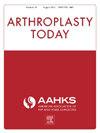全膝关节置换术中关节软骨深度的验证
IF 2.1
Q3 ORTHOPEDICS
引用次数: 0
摘要
背景:了解软骨厚度对于执行不受限制的、卡尺式运动学全膝关节置换术(TKA)至关重要。历史上,髁突软骨被认为是2毫米厚。然而,厚度可能因年龄、性别、体重指数、前交叉韧带(ACL)状态和排列而异。本研究旨在确定TKA患者的体内软骨厚度,并评估哪些因素会影响软骨厚度的变化。我们的假设是体内软骨厚度平均为2mm,但根据人口统计学因素,有些患者的软骨厚度会大于2mm。方法本研究是一项多中心、前瞻性横断面队列研究,评估髁突软骨切除碎片的厚度。采用单变量统计和一般线性模型。结果806例TKA患者未磨损股骨软骨平均厚度为:内侧远端2.0 mm;远侧2.2 mm;后内侧2.0 mm;后外侧2.2毫米。未磨损胫骨软骨平均厚度如下:脊柱内侧2.4 mm;中心1.4 mm;侧棘2.1 mm;外侧中心2.5毫米。在未磨损的股骨软骨患者中,约18.5%的患者软骨大于3mm。在胫骨软骨未磨损的患者中,约34.7%的患者软骨大于3mm。前交叉韧带功能不全与股骨后内侧软骨较薄有关。厚度的增加与年龄的年轻有关。结论a组未磨损软骨厚度大于3.0 mm,支持我们的假设。在ACL缺失的膝关节中,后内侧软骨部分磨损,应考虑MCL等距测量。年龄、性别、前交叉韧带状态、排列、体重指数和种族之间存在显著相关性。证据等级:2级,前瞻性队列研究。本文章由计算机程序翻译,如有差异,请以英文原文为准。
Validation of Articular Cartilage Depth in Total Knee Arthroplasty
Background
Understanding cartilage thickness is critical for execution of an unrestricted, calipered kinematic total knee arthroplasty (TKA). Historically, condylar cartilage was assumed to be 2 mm thick. However, thickness may vary based on age, sex, body mass index, anterior cruciate ligament (ACL) status, and alignment. This study aimed to determine in vivo cartilage thickness in patients undergoing TKA and evaluate which factors affect variation. Our hypothesis was in vivo cartilage thickness would be 2 mm on average, but some patients would have greater than 2 mm based on demographic factors.
Methods
This multicenter, prospective cross-sectional cohort study evaluated condyle cartilage thickness from resected fragments. Univariate statistics and general linear models were used.
Results
Among 806 TKA cases, the mean unworn femoral cartilage thickness was as follows: distal medial 2.0 mm; distal lateral 2.2 mm; posterior medial 2.0 mm; and posterior lateral 2.2 mm. The mean unworn tibia cartilage thickness was as follows: medial spine 2.4 mm; medial center 1.4 mm; lateral spine 2.1 mm; and lateral center 2.5 mm. In patients with unworn femoral cartilage, approximately 18.5% had cartilage greater than 3 mm. In patients with unworn tibial cartilage, approximately 34.7% had cartilage greater than 3 mm. An incompetent ACL was correlated with thinner posteromedial femoral cartilage. Increased thickness was correlated with younger age, men.
Conclusions
A subset had unworn cartilage thickness greater than 3.0 mm, supporting our hypothesis. In an ACL deficient knee, the posteromedial cartilage was partially worn and should be considered for MCL isometry. Significant correlations were found based on age, gender, ACL status, alignment, body mass index, and race.
Level of Evidence
Level 2, Prospective cohort study.
求助全文
通过发布文献求助,成功后即可免费获取论文全文。
去求助
来源期刊

Arthroplasty Today
Medicine-Surgery
CiteScore
2.90
自引率
0.00%
发文量
258
审稿时长
40 weeks
期刊介绍:
Arthroplasty Today is a companion journal to the Journal of Arthroplasty. The journal Arthroplasty Today brings together the clinical and scientific foundations for joint replacement of the hip and knee in an open-access, online format. Arthroplasty Today solicits manuscripts of the highest quality from all areas of scientific endeavor that relate to joint replacement or the treatment of its complications, including those dealing with patient outcomes, economic and policy issues, prosthetic design, biomechanics, biomaterials, and biologic response to arthroplasty. The journal focuses on case reports. It is the purpose of Arthroplasty Today to present material to practicing orthopaedic surgeons that will keep them abreast of developments in the field, prove useful in the care of patients, and aid in understanding the scientific foundation of this subspecialty area of joint replacement. The international members of the Editorial Board provide a worldwide perspective for the journal''s area of interest. Their participation ensures that each issue of Arthroplasty Today provides the reader with timely, peer-reviewed articles of the highest quality.
 求助内容:
求助内容: 应助结果提醒方式:
应助结果提醒方式:


